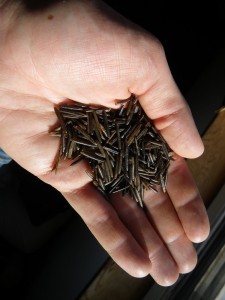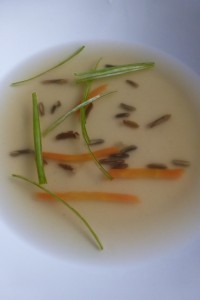 Today Judy showed up with a bag of Canada Goose wild rice from Fort Assiniboine. Wild “rice” is actually a misnomer: it’s the seed of zizania grasses, which are not part of the rice family, though they are closely related. Anyways, it’s indigenous to lakes across Canada and the northern United States.
Today Judy showed up with a bag of Canada Goose wild rice from Fort Assiniboine. Wild “rice” is actually a misnomer: it’s the seed of zizania grasses, which are not part of the rice family, though they are closely related. Anyways, it’s indigenous to lakes across Canada and the northern United States.
The harvesting of wild rice is a pretty interesting affair. Here’s a video of some hippies in Maine taking a canoe into the rice marsh.
Because of the high moisture content of the grain, wild rice actually goes through a good deal more processing than its true-rice cousins. After harvest wild rice is left in large, damp piles to mature for about a week, then dried over a fire. These steps both develop flavour and weaken the outer husk, which is later removed by threshing.[1]
Wild rice is best cooked using the “pasta method,” ie. at a vigorous boil in a large pot of water. Once the dark layer of bran has burst to reveal the starchy interior, the rice is tender enough to eat.
Wild Rice Broth: A Weird Digression
 I’ve noticed that the water left in the pot is aromatic and flavourful. To me smells and tastes very much like rooibos tea. It also has a fantastic colour and is relatively clear.
I’ve noticed that the water left in the pot is aromatic and flavourful. To me smells and tastes very much like rooibos tea. It also has a fantastic colour and is relatively clear.
It got me thinking.
I started saving my wild rice broth, usually to incorporate it into the same dish as the rice. I might, for instance, reheat the rice in a bit of its own broth. I’ve also tried infusing the broth with a bit of garlic and celery, and I think it’s good enough to be consumed as a first course.
Perhaps, with its mild astringency, the broth is better enjoyed as a tea.
Just thinking aloud.
1. McGee, Harold. On Food and Cooking. ©2004 Scribner, New York. Page 476.
